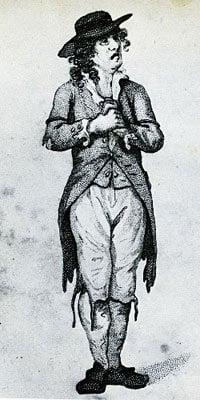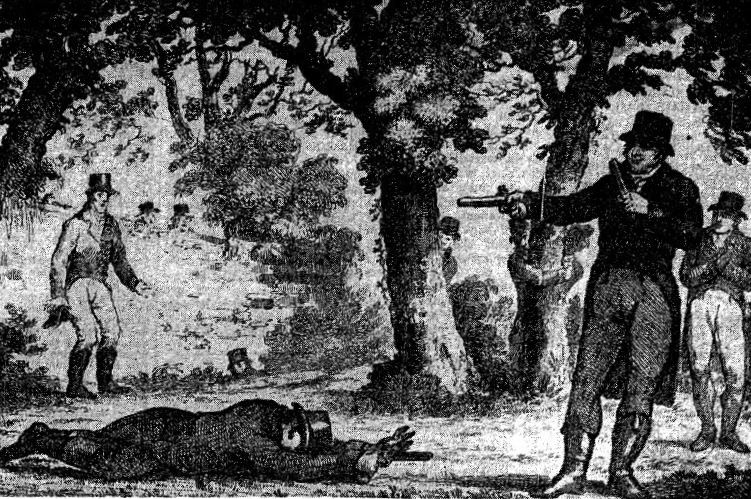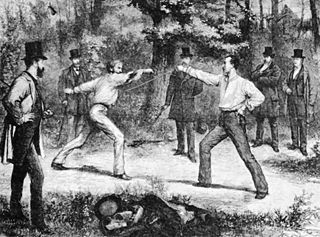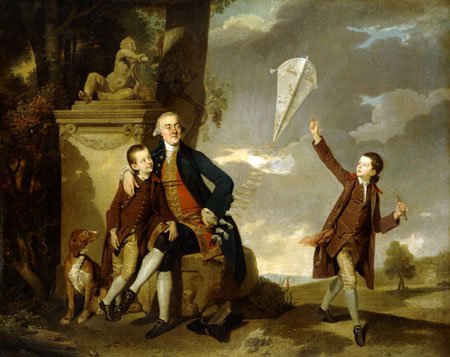George Robert Fitzgerald – “The Fighting Fitzgerald”

Duels occupied a strange position in 18th century Britain. They were not legal, nor were they illegal. Killing another person was naturally a crime, but one that carried a lesser penalty than cold-blooded murder. Those who killed their opponent in a duel faced at worst a manslaughter charge, and usually were acquitted outright unless they infringed the rules of duelling through cheating. Over the century pistols displaced swords as the weapon of choice for duelling, leading to a rise in the number of duels, but a surprising reduction in the number of fatalities. In the hands of an unskilled marksman, a pistol was far less likely to inflict a serious injury than a sword, and the pistols of the time were both far from accurate and often far from fatal when they struck, with the lead shot moving at a fairly slow velocity. Fighting a few duels became considered a mark of manhood, but the only thing worse for a man’s reputation than refusing to fight a duel was fighting too many duels. And in the ranks of those who went out actively seeking an excuse to put their life (and the life of their opponent) on the line, none stood higher than George Robert, the “Fighting Fitzgerald”.
George was born around 1748, the son of a notorious rake and magistrate also named George, and Lady Mary Hervey [1]. Both his parents were noble-born, with George the elder coming from the famous Desmond branch of the Fitzgeralds, while Lady Mary’s three brothers each held the title of Earl of Bristol (the first two dying without sons). [1] It was not a happy marriage however, with George’s father openly flouting his mistress, and the two separated some time around 1750. Lady Mary took George and his younger brother Charles to England, where they attended Eton. George joined the army at the age of seventeen, reportedly having fought his first duel the year before. He was part of the 69th regiment, which was stationed in Ireland, and fought several duels with both locals and with his fellow officers. In one of these (allegedly fought over a woman) he was shot in the head and nearly killed, and only a swift trepanation saved his life. It’s possible that this brain injury may explain his aggressiveness later in life. His father was annoyed enough at the incident to cut him out of his will.

George was left scarred but by no means unattractive. Though he was beneath average height for the time, and fairly slight of build, he did always impress those he met with his graceful bearing, and even those who hated him admitted “a more polished and elegant gentleman could not anywhere be met with”. In 1770 he married Jane Connolly, daughter of an Irish politician. The marriage came with a £30,000 dowry – a fantastic sum at the time. This led to an appeal for help from his father, who was in financial difficulties, and for the sum of £10,000 it was agreed that his father would pay him £1000 a year for life, and also reverse the disinheritance. After his wedding George resigned his commission in the army and moved to France, where within a year he had lost all of the remaining £20,000 gambling. Jane went back to England, while George stayed on in Paris for a while. Eventually, however, his blatant refusal to repay his gambling debts caught up with him, and the Count d’Artois (the future King Charles X of France) had him thrown out of a gambling hall. This effectively destroyed him in Parisian society – ironically the only remedy would have been to challenge Charles to a duel, but no mere commoner could presume to challenge a prince. Instead, he was forced to leave the country.
 In England, however, the ignominy inflicted on him by the prince was barely considered, while his mother’s good family and his own dashing reputation stood him in good stead at first. However once again a gambling debt was to ruin his standing – this time one owed to him by a young Lieutenant Walker. The debt was bought off for a lesser amount by Walker’s guardians, but George continued to hound the young man, eventually forcing him into a duel at Ascot racecourse. Walker fired first and missed, and George then proceeded to spend a long time humiliating him by pretending to fix a flaw in his pistol, offering a mocking apology, and reiterating his financial demands before finally shooting the young man in the shoulder. The resulting disapproval forced him to quit the London scene, and try a return to France as a horse trader, which again was terminated by a duel. This was with a Major named Baggs, a former comrade from the 69th. Baggs ran a gambling house, and the two fell out over the matter of the commission owed to George for steering a naive young nobleman into Baggs’ clutches. The two fought their duel outside the city, over the border into Austria, as they had been forbidden from duelling in France. The duel was a far from honourable affair – Fitzgerald used his favourite trick of lunging forward with his arm extended to present a smaller target, while Baggs, despite his leg being broken by George’s first shot, charged the other man and fired his second pistol. Neither was killed, but both were left with permanent limps.
In England, however, the ignominy inflicted on him by the prince was barely considered, while his mother’s good family and his own dashing reputation stood him in good stead at first. However once again a gambling debt was to ruin his standing – this time one owed to him by a young Lieutenant Walker. The debt was bought off for a lesser amount by Walker’s guardians, but George continued to hound the young man, eventually forcing him into a duel at Ascot racecourse. Walker fired first and missed, and George then proceeded to spend a long time humiliating him by pretending to fix a flaw in his pistol, offering a mocking apology, and reiterating his financial demands before finally shooting the young man in the shoulder. The resulting disapproval forced him to quit the London scene, and try a return to France as a horse trader, which again was terminated by a duel. This was with a Major named Baggs, a former comrade from the 69th. Baggs ran a gambling house, and the two fell out over the matter of the commission owed to George for steering a naive young nobleman into Baggs’ clutches. The two fought their duel outside the city, over the border into Austria, as they had been forbidden from duelling in France. The duel was a far from honourable affair – Fitzgerald used his favourite trick of lunging forward with his arm extended to present a smaller target, while Baggs, despite his leg being broken by George’s first shot, charged the other man and fired his second pistol. Neither was killed, but both were left with permanent limps.
George found France too hot to hold him after the Baggs affair, and moved to Dublin in 1775. It was here that his eccentricity and mania for duelling began to take full hold. He would knock the wigs off strangers in the street to force them to challenge him, or stand in the middle of the pathway so that one had to step into the mud to get around him, or jostle him out of the way (immediately being challenged for the insult). The most bizarre thing he did was to adopt a pet bear, and take it everywhere with him, with mistreatment or mockery of the bear being, of course, grounds for a duel. [2] The number of duels he fought in became so great that it would be quicker to simply add the line “and he fought a duel against Fighting Fitzgerald” to every notable Dublin man of the time’s biography, and one would be right more often than not. One story of the time has Fitzgerald fighting a sword duel in St Stephen’s Green in the middle of the day, to the consternation of onlookers. Some called for them to be parted, but the consensus opinion was “let them fight it out; one will probably be killed, and the other hanged for the murder, and society will get rid of two pests.” In fact, neither man was killed though one (it is not recorded which) suffered a wound that left him unable to sit down for a week. In fact, Fitzgerald seems to have avoided killing his opponents, whether through luck or through the knowledge that his known temperament would see him treated severely by the courts.

In 1778 George moved back from Dublin to Turlough. At this stage his father owed him nearly £12,000 in the annuity plus interest, and George took legal action against him. His father’s lawyer was a local solicitor named Patrick Randall McDonnell, while George was acted for by a friend of his named Timothy Brecknock. Brecknock had trained at Oxford (though he never got a degree), and at first practised in London. The highlights of his career there included getting a highwayman found innocent through fraud, and having his satirical works declared sedition and (as was tradition) publicly burnt by the hangman. Now in his sixties, he had attached himself to George and his experience trumped that of young McDonnell. George took possession of the house and estates, but his father conspired with McDonnell and George’s younger brother Charles to sell a lease on part of the estates. When the man who bought the lease (a Galwegian named Caesar French) sought to put his cattle on the estates, George took great offence at this “trespassing”, and naturally the two fought a duel. French being defeated, he gathered a force of his friends from Galway to take the land by force, but Fitzgerald had his own band of “militia” and a battle ensued. This time French was the victor and took over the land. George was arrested for his part in the affair, but managed to escape. In retaliation against his father for having started the whole affair, George had him kidnapped. The old man was hidden in a cave. In one of the most bizarre twists in the story, in order to keep him from escaping he was manacled to George’s trusty pet bear (who had moved down from Dublin with his master). His father, perhaps naturally, agreed to sign over all his interest in the estates to George if he was moved to Dublin, but once they got there he refused to do so, and let people know who George was. There was still a reward out for his arrest, and he was soon apprehended. He was sentenced to three years in prison, though he was released early due to a claim of ill health.
In 1780, while all the above was going on, George’s wife Jane died. Though he had been neglectful of her in life, he made a great show of grieving her in death, to such an extent that it was considered almost unseemly by some. When he was imprisoned their daughter was taken in by her relatives in England, and George had no further part in her upbringing. On his release from prison in 1782, he first set out on revenging himself on one of the barristers who had helped convict him, a man named Richard Martin. Martin was known as “Hair-trigger Dick” in his youth for his temper, but had by this time in his life sworn off duelling and refused to be drawn. George returned to Turlough in a sulk, where he was forced to lower his standards of living considerably, as his house had been looted by the locals while he was imprisoned. [3] He still had Brecknock, however, as well as a manservant named Andrew Craig (known as Scotch Andrew, though he was an Ulster Scot rather than a Scottish one). He also remarried that year to a local woman named Sydney Vaughn. He finished the year off in his usual style by finally managing to get a challenge from Martin by visiting his house and shooting his pet wolfhound dead. In the ensuing duel, George was lightly wounded, while Martin was shot in the chest and left bedridden. While he was unconscious, George is said to have visited him and shown nothing but cheerful concern, acting as though Martin was now one of his dearest friends.

In 1784, George received the freedom of the city of Londonderry (possibly due to his uncle’s influence), showing how his reputation had been repaired since his imprisonment. His downfall came through his ongoing feuds with the local barrister who had worked on his father’s behalf, Patrick Randall McDonnell. The two vied for leadership of the Mayo scene, with their partisans staging attacks on each other’s property. On one occasion, some of McDonnell’s men killed George’s prize hunting hounds, as well as wounding Craig. Eventually, matters came to a head, though the exact reason is a matter of dispute. Some reports have it that it was caused by Brecknock kidnapping McDonnell’s fiancee to force her to marry him, until she was rescued by McDonnell. Others have it that it was when McDonnell defeated George in the leadership election for the local militia, and George saw his biggest source of local influence threatened. Regardless, George (in his capacity as a Justice of the Peace) had McDonnell and several of his men arrested on trumped up charges. They managed to escape, but in the pursuit McDonnell and several of his men were killed. George, Craig and Brecknock were all arrested. Craig, who had actually carried out the killings, turned state’s evidence and was sent to jail. George and Brecknock were both sentenced to death.
George Robert Fitzgerald was hanged for murder alongside Brecknock on the 12th June, 1786. On the first attempt, the rope broke. He joked that the courts of Mayo were too mean to afford a rope sufficiently strong to hang him, but the replacement proved more than adequate for the job. His body was borne back to Turlough House, which had once again been looted by the locals. So thorough had they been that not a single candlestick remained, and his widow was forced to use candles in bottles to light his wake. His daughter remained unaware of her father’s fate until she discovered it in reading a magazine eight years later, which is said to have caused her to die an early death of shame. Another story has it that grave robbers dug Fitzgerald up, years later, in order to steal a ring he had been buried wearing and found his skull with a vast chunk missing, a legacy of his early head injury. Perhaps that wound explains his aggressive nature – some who have suffered similar injuries have had difficulty controlling their emotions, and his grief at the death of his first wife would also bear this out. As with Martin, he never bore a man a grudge once he had duelled him, and though he was one of the most notorious duellists of the 18th century, he never killed a man (and he does not seem to have planned to kill McDonnell). In the end, it is as Fighting Fitzgerald that he is remembered – the most notorious duellist Ireland ever produced.
[1] The youngest of the three brothers, Frederick, was an Anglican bishop and was once imprisoned in a castle in Milan. The Herveys were a notoriously eccentric clan.
[2] One story, given in the Dublin University Magazine tells of how George went down to Turlough with a young lawyer’s assistant and a “hooded figure”, who the young man took for a foreigner as he seemed to only grunt unintelligibly. It was, of course, the bear, which Fitzgerald used to terrify the young man into fleeing across the countryside.
[3] Martin was hated by the local Catholic farmers for having evicted large numbers of them to make room for 200 linen workers he brought down from Ulster to set up a factory.
